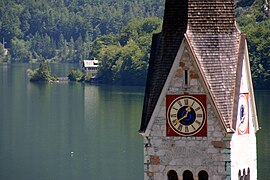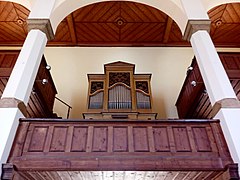Evangelical parish church in Hallstatt
The Evangelical Parish Church of Hallstatt is located in the Hallstatt community in the Gmunden district . The current sacred building dates from 1859 to 1863 and replaced the prayer house from 1785. The church is a parish church of the Evangelical Church AB in Austria and belongs to the Evangelical Superintendentur Upper Austria . The church is also known as the Christ Church . The Protestant parish church AB von Hallstatt is under monument protection ( list entry ).
The Protestant parish church
On October 30, 1785, a prayer house was inaugurated in Hallstatt. It stood at today's Mühlbach estuary, had rectangular windows and no bell tower. There was space for 355 people. In 1859 two old salt paver houses were purchased, demolished and the new Protestant church was built on the property with a construction period until 1863.
Ludwig Lange from Munich designed the building plan for the church . According to the foundation deed of October 15, 1863, the construction costs amounted to 37,000 guilders . The funds were made available by a number of benefactors and the Gustav Adolf Association. The Christ Church Hallstatt has 550 seats. The altar is made of oak. The colored altarpiece is from an academic painter. The slider chest organ , which was bought by the Catholic Church in Ebensee in 1810 and was already in service in the prayer house, was also put up again in the church. The four bells were delivered a year late (1864). The old tolerance prayer house was sold in 1864 and demolished in favor of a new landing stage for the Hallstätter See shipping company.
During the First World War , the Christ Church had to deliver all four bells as well as deliver 35 organ pipes and replace them with zinc pipes. The new bells purchased in 1934 were melted down again in 1943. Between 1957 and 1961 the roof of the church was renewed; there is evidence of an interior renovation for 1962. From 1977 three new bells (Faith, Hope, Love) rang again. After a mudslide in 2013, water damage had to be repaired.
- Picture gallery
History of the Protestant Parish
16th to 18th century
Around 1560 there are two permanent evangelical preachers in Hallstatt. On July 29, 1601, the Salzamtmann Veit Spindler von Hofenegg, who was the highest official appointed by the Emperor in the Salzkammergut, promulgated counter-Reformation decrees in Hallstatt. Thereupon he and his entourage were captured by the angry crowd and escorted to Bad Ischl under humiliating circumstances. In the course of the Salzkammergut uprising there were revolts against the authorities in the towns of the Inner Salzkammergut up to the spring of 1602. From February 1602 troops of the Prince Archbishop and sovereign of Salzburg Wolf Dietrich von Raitenau intervened. Wolf Dietrich had been asked for support by the Habsburgs. After 1,200 archiepiscopal soldiers moved into the Ischl area along the Wolfgangsee and 200 men via Gosau, the uprising of the badly armed Salzkammergut residents collapsed.
For the next 180 years or so, the Protestant faith could only be lived in the form of secret Protestantism . Between 1734 and 1737 Protestant citizens of the Salzkammergut were as so-called Landler for transmigration of Transylvania forced. 122 Evangelicals are documented from Hallstatt who were transported away.
Since the tolerance patent of 1781
The political situation changed only after the tolerance patent of Emperor Joseph II. The prerequisites for a prayer house were at least 100 Protestant families or 500 individuals.
In the Inner Salzkammergut , the tolerance community Bad Goisern was the first "tolerance community" in 1782 , followed by the tolerance community Gosau in 1784. In Hallstatt, 583 evangelicals also registered, but due to a lack of financial resources, no parish could be founded for the time being. The prayer house, inaugurated on October 30, 1785, was a branch of the Goisern pastorate. Once a month the pastor from Bad Goiserer came to see St. Last Supper, otherwise reading services had to be held.
In 1831 Princess Therese Mathilde Amalie von Thurn und Taxis (nee Duchess of Mecklenburg-Strelitz) visited Hallstatt. The princess donated the sum of 5,000 guilders and thereby enabled the employment of a pastor and the independence of the Hallstatt community. The state approval for the elevation of the parish took place in 1836. Konrad Ludwig von Sattler was appointed the first Hallstatt pastor in 1837. A parsonage was built in 1840. The Protestant Christ Church was rebuilt in 1859. In addition to the Thurn and Taxis and Mecklenburg-Schwerin families , the Queen of Prussia Elisabeth Ludovika , Friedrich Hebbel , Chancellor Otto von Bismarck and Adalbert Stifter contributed significantly to the financing of the construction project at.
The fact that several German princely families supported the evangelical communities in the Salzkammergut was partly due to the fact that the nearby Bad Ischl was the summer residence of the Austrian emperor and thus the meeting place of the high aristocracy. For example, the Evangelical Parish Church in Bad Ischl was created with significant support from the Grand Duke of Mecklenburg-Schwerin Friedrich Franz II . In terms of church history, the parishes of Hallstatt and Bad Ischl are linked in that both were founded by the evangelical parish of Bad Goisern.
During the construction of the church, Emperor Franz Joseph I issued the Protestant patent from 1861, which made it possible for Evangelicals to be largely equated with Catholics. Pastor Konrad handed over the office to his son Friedrich von Sattler in 1879, who held the pastoral position until 1925. During his tenure in 1906 the prayer house in Obertraun belonging to the parish was inaugurated. Other pastors were Hellmut Bergmann (1935–1955), Hermann Mittermayr (1955–1965), Till Geist (1965–1968), Karl Pilzecker (1969–1979) and Ernst Günther Goetze from 1980. In 1985 the celebrations for the 200th anniversary took place of the community (including the time as a branch of Goisern). Also in 1985 the construction of the first house of prayer 200 years ago was thought of. Two anniversaries were celebrated in 2013: 150 years of the Christ Church in Hallstatt 1863-2013 and 500 years of Protestantism in Hallstatt and Obertraun 1563-2013 . Dankfried Kirsch has been the Protestant pastor of Hallstatt-Obertraun since September 1, 2014.
Evangelical school and prayer house in Obertraun
The Protestant prayer house in Obertraun , like the preaching station on Krippenstein, also belongs to the pastoral care area of the Protestant parish church in Hallstatt.
The Princess of Hohenzollern-Hechingen made a Protestant school in Obertraun possible with the donation of 4,500 guilders. The building served as a Protestant primary school from 1867. In 1906 the school building was converted into a prayer house. A renovation took place in 2014. The evangelical school and prayer house in Obertraun is a listed building ( list entry ).
Politically, a district was separated from Hallstatt in 1920 and became an independent political municipality as Obertraun . The Protestant parish still includes both places. At the 1981 census there were 794 Catholics and 277 Protestants in Hallstatt, 325 Catholics and 386 Protestants in Obertraun.
literature
- Association for the publication of a district book Gmunden (ed.): The district of Gmunden and its communities. From the beginning to the present . Upper Austrian Provincial Publishing House , Linz 1991.
- Bundesdenkmalamt (Ed.): Dehio-Handbuch Oberösterreich . 3. Edition. Anton Schroll & Co, Vienna 1958.
- Peter F. Barton: Evangelical in Austria . 1st edition. Böhlau Verlag , Vienna Cologne Graz 1987, ISBN 3-205-05096-7 .
Web links
- Homepage of the Evangelical Superintendent of Upper Austria
- Homepage of the Evangelical Parish Hallstatt-Obertraun
Individual evidence
- ↑ a b c d e f g h i Leopold Temmel: The Evangelical Church in the Gmunden district . In: Association for the publication of a district book Gmunden (Hrsg.): The district of Gmunden and its communities . From the beginning to the present. Upper Austria. Landesverlag. Linz 1991. pp. 523-539.
- ↑ Bundesdenkmalamt (Ed.): Dehio-Handbuch Oberösterreich . 3. Edition. Anton Schroll & Co, Vienna 1958, p. 107 .
- ↑ a b c d e 150 years of Christ Church in Hallstatt 1863–2013. (No longer available online.) Evangelical Parish AB Hallstatt – Obertraun, December 1, 2013, archived from the original on April 15, 2015 ; Retrieved April 8, 2015 . Info: The archive link was inserted automatically and has not yet been checked. Please check the original and archive link according to the instructions and then remove this notice.
- ^ Ischler Heimatverein (ed.): Bad Ischl Heimatbuch 2004 . Wimmer Verlag, Bad Ischl 2004, ISBN 3-900998-70-1 , p. 587-604 .
- ^ A b Peter F. Barton: Evangelical in Austria . 1st edition. Böhlau , Vienna Cologne Graz 1987, ISBN 3-205-05096-7 , p. 129, 203 .
- ^ Hubert Unterberger, Heinrich Marchetti: Hallstatt. Community mirror and history . In: Association for the publication of a district book Gmunden (Hrsg.): The district of Gmunden and its communities . From the beginning to the present. Upper Austria. Landesverlag. Linz 1991. p. 1008.
- ^ Roman Pilz, Heinrich Marchetti: Obertraun. Community mirror and history . In: Association for the publication of a district book Gmunden (Hrsg.): The district of Gmunden and its communities . From the beginning to the present. Upper Austria. Landesverlag. Linz 1991. p. 1074.
Coordinates: 47 ° 33 ′ 45.8 ″ N , 13 ° 38 ′ 58.3 ″ E









